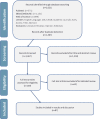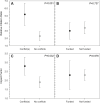Funding has no effect on clinical outcomes of total joint arthroplasty emerging technologies: a systematic review of bibliometrics and conflicts of interest
- PMID: 36316729
- PMCID: PMC9623935
- DOI: 10.1186/s42836-022-00146-3
Funding has no effect on clinical outcomes of total joint arthroplasty emerging technologies: a systematic review of bibliometrics and conflicts of interest
Abstract
Background: The use of new total joint arthroplasty technologies, including patient-specific implants/instrumentation (PSI), computer-assisted (CA), and robotic-assisted (RA) techniques, is increasing. There is an ongoing debate regarding the value provided and potential concerns about conflicts of interest (COI).
Methods: PRISMA guidelines were followed. PubMed, MEDLINE, and Web of Science databases were searched for total hip and knee arthroplasties, unicompartmental knee arthroplasties (UKA), PSI, CA, and RA. Bibliometric data, financial COI, clinical/functional scores, and patient-reported outcomes were assessed.
Results: Eighty-seven studies were evaluated, with 35 (40.2%) including at least one author reporting COI, and 13 (14.9%) disclosing industry funding. COI and industry funding had no significant effects on outcomes (P = 0.682, P = 0.447), and there were no significant effects of conflicts or funding on level of evidence (P = 0.508, P = 0.826). Studies in which author(s) disclosed COI had significantly higher relative citation ratio (RCR) and impact factor (IF) than those without (P < 0.001, P = 0.032). Subanalysis demonstrated RA and PSI studies were more likely to report COI or industry funding (P = 0.045). RA (OR = 6.31, 95% CI: 1.61-24.68) and UKA (OR = 9.14, 95% CI: 1.43-58.53) had higher odds of reporting favorable outcomes than PSI.
Conclusions: Author COIs (about 40%) may be lower than previously reported in orthopedic technologies/techniques reviews. Studies utilizing RA and PSI were more likely to report COI, while RA and UKA studies were more likely to report favorable outcomes than PSI. No statistically significant association between the presence of COIs and/or industry funding and the frequency of favorable outcomes or study level of evidence was found.
Level of evidence: Level V Systematic Review.
Keywords: Computer-navigated; Conflict of interest; Funding; Patient-specific implant; Robotic-assisted; Total joint arthroplasty.
© 2022. The Author(s).
Conflict of interest statement
The authors declare that they have no competing interests.
Figures





References
-
- Yan CH, Chiu KY, Ng FY, Chan PK, Fang CX. Comparison between patient-specific instruments and conventional instruments and computer navigation in total knee arthroplasty: a randomized controlled trial. Knee Surg Sport Traumatol Arthrosc. 2015;23(12):3637–45. doi: 10.1007/s00167-014-3264-2. - DOI - PubMed
-
- Lin Y, Cai W, Xu B, Li J, Yang Y, Pan X, et al. Patient-Specific or Conventional Instrumentations: A Meta-analysis of Randomized Controlled Trials. BioMed Res Int. Hindawi Limited. 2020;2020. Available from: /pmc/articles/PMC7085852/. [Cited 2021 Apr 20]. - PMC - PubMed
LinkOut - more resources
Full Text Sources
Research Materials
Miscellaneous
